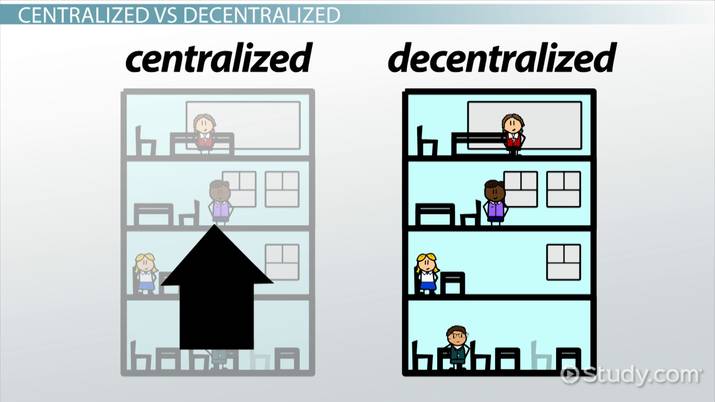Marketing centralization and standardization has been an important topic of research for marketers over the years and continues to be crucial in the future. Centralization of marketing efforts refers to the implementation of steady, uniform marketing and communication programs or processes, across all national and international boundaries. Centralization marketing structure involves all marketing decisions performed at the company’s head office. In a decentralized structure, on the other hand, the marketing decision is either jointly made by the corporate office and a local representative, or can also be forwarded to the local representation. A centralized structure is usually followed when setting up a national or internal franchise system.
Franchise or branch is referred to as a system of codependent establishment that is involved in the process of making a product or service available to the consumer through negotiation and/or exchange. Some franchises or branches are operated directly by the central corporation, which owns the overall name and the operating rights of business. Despite having legal sovereignty, parties in a franchise system are commercially and economically codependent. In majority cases, the franchisor is usually responsible for handling marketing and promotional efforts for all franchisees. This creates a desired demand for the product or service, hence, elevating footfall for all respective operations. The promotional messages tend to be strategic, uniform, and aligned with the corporate strategy.
On the other hand, the franchisee is responsible for all operational efforts and investments, with only a few individuals responsible for planning and reporting. The head of branch or franchise, in many cases, the branch manager, is involved in planning and reporting of resources such as employee schedules, inventories, supplies, etc., as well as a few marketing initiatives. Customer service and product delivery are key elements that differentiate one franchise from another, apart from other factors like location. The franchisee is responsible for everything happening inside the branch or franchise. External dilemmas are generally sorted by the corporate or head office. But what happens when the franchisee recognizes a problem and the franchisor does not? Such situations mainly occur in marketing efforts, when one franchise or branch wants to employ a strategy but is restrained due to hierarchal structures and processes.
A similar problem was faced by the client assigned to the team. Centre for Education & Training (TCET) Parliament location’s main marketing problems consisted of branch awareness and the lack of social media control, specifically for the Parliament branch. The branch also lacked a definite identification of its leading target group. All marketing problems were recognized by looking through a combination of the branch’s current outdoor advertising, communication and promotion strategy, and from an in-depth interview with the branch manager. When questioned about the criteria, all fingers were pointed towards the corporate head office in Mississauga. A disconnect of brand name and the functionality of the organization was also concluded in the research conducted by the team. Many consumers assumed TCET Parliament location as a centre that offers education and training when in fact, the Parliament location offers employment guidance services only. Due to weak presence across social media platforms and having the need to rely heavily on word of mouth referrals, according to the branch representative, TCET was prone to pre-dispositioned attitudes and beliefs set by society. In this case, the law of perception was clearly violated by the overall perception defined by the corporate head office, with the local branch having no power to anticipate it.
The Parliament branch had a combined marketing budget of $600/month to conduct any promotional activities related to the location. Most of the budget was spent on printing and distributing flyers, which were clearly unprofessional and outdated, promoting job postings online on mediums like LinkedIn and Indeed, and any other miscellaneous marketing cost. TCET head office, however, provided a few takeaway materials to the applicants that were working with a counsellor. The giveaway package included a motivational folder labelled “HIRED”. The folder contained important information that encouraged the respective client’s job focus, such as monthly calendars, which contained job developing workshops offered by TCET, ongoing job vacancies in a few companies, as well as upcoming job fairs or events taking place during the month. The folder also contained information on top online job search websites that may help the client expand his/her job searching network.
Along with the folder, other branded day-to-day use giveaways such as water bottles, USBs, coffee mugs, notepads, fidget spinners, etc., were also provided. A drawback from many of these giveaways was that several items did not promote the Parliament location on it, causing prospective clients to end up at the wrong location with the assumption that all TCET locations offer the same services. This would have been a useful strategy if all TCET location provided similar services. The company was clearly facing a state of inertia, and it was about time to do something about it. The branch was looking to anticipate in achieving targets but was very much restraint due to a lack of autonomy.
Considering all parameters, limitations and the structure of the Parliament location branch, the marketing team worked on creating a tight marketing plan embodied with goals, strategic initiatives, and tactics. The key initiatives recommended to the client included:
- Digital QR Code: A QR code mainly made to promote the specific branch, with creative messages around prompting branch awareness and employment services offered by the Parliament location. The idea was recommended because the creation and execution of an idea is relatively inexpensive, internet/digital sources were found to be the preferred tool for 91.4% of the suggested target market and the idea catered to the target market’s short attention span
- Storefront window redesign: When evaluating the outdoor display of the branch, the team came across a poor outdoor display of the branch. Ample space was available for promoting in-house activities, but a lack of clear visibility resulted otherwise. A digital redesign of the storefront was recommended to increase foot traffic that was targeted towards the customer, increase brand awareness and display current job opportunities organized by types of employment, i.e, seasonal, part-time, full-time, etc.
- On ground Activities and Events: To move more towards the consumers in a cost-effective way, targeting on-ground activities and events was also added to the strategic initiatives. The was recommended to was enhance personal interactions with the target market and create an established database of potential consumers.
While discussing the marketing plan, the team found many ambiguities in the client’s perspective. The original objective of the plan was to focus on establishing marketing objectives for the Parliament location, but as the meeting went by, the focus started to pivot towards a corporate strategy in perspective. This undermined the operating space of the Parliament location, also creating a state of confusion for the third party hired. From the discussion with a corporate head office marketing representative, the team concluded that many marketing initiatives used in the centralized corporate marketing strategies were insufficient and outdated. The blame was more given to the nature of business (NGO), with a very low emphasis on implementing innovation.
The team also presented a few future recommendations for the branch to implement and the head office to strictly consider. The initiatives included: focusing on gaining branch autonomy of its social media presence, owning a personal website or subsection of the organization’s website, changing the outdoor vertical poster, increasing corporate partnerships and using above the line advertising such as outdoor and transit.
TCET is an excellent example of a business failing to understand the marketing laws of Focus, Exclusivity, Acceleration and Sacrifice. The company is in a clear state of inertia. It still feels to implement recommendations that were successful in the past. For many NGOs, marketing is considered as an expense, rather an investment. They fail to realize the importance of social responsibility and the impact it has on brand equity, including all parties or companies associated with the NGO.
In the modern world of disruption, businesses are highly likely to fail if they do not keep up with the right technological advancements, demands, processes and systems. This also included all hierarchical systems as it may become an obstacle when adapting to consumer needs and implementing innovation. When a problem or an opportunity is identified by front-line representatives and managers, there are ordered to follow protocol and wait for further instruction. By the time the information follows to the top and comes back with a solution, the opportunity has either passed or the damage has been already caused.
Salim Ismail, author of the book “Exponential Organization” quotes, “Any organization or company designed for success in the 20th Century is doomed to failure in the 21st Century.’’ With consumers evolving day-by-day, businesses crucially need to realize the importance of modern leadership and autonomy.





